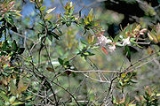
Abelia
Overview
Genus
In biology, a genus is a low-level taxonomic rank used in the biological classification of living and fossil organisms, which is an example of definition by genus and differentia...
of about 15-30 species
Species
In biology, a species is one of the basic units of biological classification and a taxonomic rank. A species is often defined as a group of organisms capable of interbreeding and producing fertile offspring. While in many cases this definition is adequate, more precise or differing measures are...
and many hybrids in the honeysuckle family Caprifoliaceae
Caprifoliaceae
The Caprifoliaceae or honeysuckle family is a clade consisting of about 800 dicotyledonous flowering plants, with a nearly cosmopolitan distribution; centres of diversity are found in eastern North America and eastern Asia, while they are absent in tropical and southern Africa.They are mostly...
Some authors, including the Angiosperm Phylogeny Group
Angiosperm Phylogeny Group
The Angiosperm Phylogeny Group, or APG, refers to an informal international group of systematic botanists who came together to try to establish a consensus on the taxonomy of flowering plants that would reflect new knowledge about plant relationships discovered through phylogenetic studies., three...
, considers Abelia and related genera to belong instead in the segregate
Segregate (taxonomy)
In taxonomy, a segregate, or a segregate taxon is created when a taxon is split off, from another taxon. This other taxon will be better known, usually bigger, and will continue to exist, even after the segregate taxon has been split off...
family Linnaeaceae, also including such genera as Linnaea, Abelia, Dipelta, Kolkwitzia, and Zabelia, but not such others as Lonicera or Symphoricarpos
Symphoricarpos
Symphoricarpos, with common names in English of Snowberry, Waxberry or Ghostberry, is a small genus of about 15 species of deciduous shrubs in the honeysuckle family, Caprifoliaceae. All species are natives of North and Central America, except one native to western China...
, included by them instead in a more narrowly viewed Caprifoliaceae.
Abelias are shrub
Shrub
A shrub or bush is distinguished from a tree by its multiple stems and shorter height, usually under 5–6 m tall. A large number of plants may become either shrubs or trees, depending on the growing conditions they experience...
s from 1–6 m tall, native to eastern Asia
Asia
Asia is the world's largest and most populous continent, located primarily in the eastern and northern hemispheres. It covers 8.7% of the Earth's total surface area and with approximately 3.879 billion people, it hosts 60% of the world's current human population...
(Japan
Japan
Japan is an island nation in East Asia. Located in the Pacific Ocean, it lies to the east of the Sea of Japan, China, North Korea, South Korea and Russia, stretching from the Sea of Okhotsk in the north to the East China Sea and Taiwan in the south...
west to the Himalaya) and southern North America
North America
North America is a continent wholly within the Northern Hemisphere and almost wholly within the Western Hemisphere. It is also considered a northern subcontinent of the Americas...
(Mexico
Mexico
The United Mexican States , commonly known as Mexico , is a federal constitutional republic in North America. It is bordered on the north by the United States; on the south and west by the Pacific Ocean; on the southeast by Guatemala, Belize, and the Caribbean Sea; and on the east by the Gulf of...
); the species from warm climates are evergreen
Evergreen
In botany, an evergreen plant is a plant that has leaves in all seasons. This contrasts with deciduous plants, which completely lose their foliage during the winter or dry season.There are many different kinds of evergreen plants, both trees and shrubs...
, and colder climate species deciduous
Deciduous
Deciduous means "falling off at maturity" or "tending to fall off", and is typically used in reference to trees or shrubs that lose their leaves seasonally, and to the shedding of other plant structures such as petals after flowering or fruit when ripe...
.
Discussions

